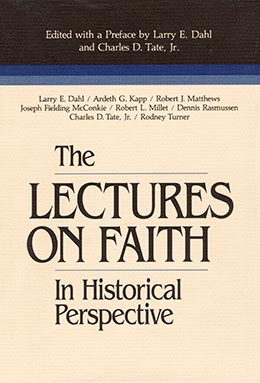Introduction to the 1990 Edited Version
Charles D. Tate Jr., Editor
Introduction to The Lectures on Faith in Historical Perspective, ed. Larry E. Dahl and Charles D. Tate Jr. (Provo, UT: Religious Studies Center, Brigham Young University), ix.
One of the major purposes in publishing this 1990 edited version of the Lectures on Faith is to maintain the integrity of the text of the 1835 edition and at the same time make the Lectures easier to read. To accomplish this we have used the 1835 edition as our base text. However, as we studied all the editions that have been published since 1835, we recognized that some of the changes made in the later editions have become so widely accepted and make such good sense that we need to retain them in this version. For example, the title to the early editions of the lectures was simply “Of Faith,” but later editions changed it to “Lectures on Faith” (see “Authorship and History” above). We have also adopted the modern reference to the different lectures as “Lecture 1,” “Lecture 2,” in place of the 1835 “Lecture First,” “Lecture Second,” etc.
In our study of the 1835 Lectures, we found several places where the meaning is generally not clear or is difficult for the modern reader to understand. We have tried to make the text clearer and easier to read by doing several things: we have corrected misspelled words, misquotations, grammatical and clarity problems, and a few simple mistakes that were printed in the 1835 edition. For example, in one instance in the Question and Answer section to Lecture 2, Nahor is called Abraham’s father. Nahor is the name of both Abraham’s grandfather and one of his brothers, but his father was Terah. We changed “father” to “brother” since it is obvious from the context that the reference was to his brother. Also in Lecture 2, the names of Arphaxad and Methuselah are consistently misspelled. We have corrected those spellings.
We have made the text more readable and easier to understand by breaking several very long and complex sentences into shorter, easier-to-read units simply by punctuating those units with periods rather than colons or semicolons. We have also made other difficult sentences clearer by rearranging the phrases and clauses to let the ideas flow more easily.
To show the reader precisely what we changed in the 1835 text, we have made a chart (Chart 1) showing all our specific word and phrase changes. When word changes or corrections are frequent and repetitive, we mention them in blanket statements at the beginning of the charts, and the reader can assume that each time the word appears in the 1990 edition, it has been changed from the 1835 edition.
The references to the Book of Mormon in the 1835 edition of the Lectures are to page numbers in the 1830 edition of that scripture [1] because the paragraphs or verses had not yet been numbered. We left the page number references as they were used in the 1835 edition of the Lectures and added references to the 1981 edition of the Book of Mormon in parentheses for our readers’ convenience.
Additionally, we have made five blanket changes which we describe here but do not note in Chart 1. First, we have made all scriptural quotations conform to the language and spelling of the printed versions of the Joseph Smith Translation (JST), the King James Version, and the other scriptures.
The writers of the 1835 edition often indicated that they were “copying” a scriptural reference from the “New Translation,” which came to be what we now call the Joseph Smith Translation (JST), but they were actually paraphrasing. They used the familiar pronouns he, you, and your, rather than the biblical thee, thou, thy, and thine, which are used in the JST, and they also left the biblical suffixes off the verbs. We have made all these references conform with the printed text. We have also added corresponding references to the book of Moses in the Pearl of Great Price, where applicable, following the 1985 Deseret Book edition, which was the first to do this.
Second, we have standardized internal scriptural citations by placing them in parentheses after the quotation or reference and using Arabic numerals to identify chapters and verses. The 1835 citations generally preceded the reference, and the chapter and verse notations were sometimes written out and other times listed in numerals.
Third, we have changed punctuation as we sensed it needed to be changed to facilitate the flow of the thought and to make this edition conform to modern punctuation rules.
Fourth, we have standardized the use of numbers within the text by changing all numbers above ten to numerals and writing out all numbers ten and below except in the lecture titles. Fifth, we have added the heading “Questions and Answers” for Lectures 1, 2, 3, 4, and 5 to introduce what the original writers clearly thought were the second parts of those lectures. We numbered the questions to facilitate referencing. There were no question-and-answer sections for Lectures 6 or 7 in the 1835 edition.
We also deleted the subheadings SECTION I, SECTION II, etc., which appeared at the head of each lecture in the 1835 edition, and we have changed all references to these subheadings to refer to the lecture concerned instead. We did this because the section numbers were redundant with the numbers in the titles of the lectures and their use was discontinued after the 1876 edition.
We have also included a second comparative chart (Chart 2) showing the changes made in the 1876, 1891, and 1985 editions to facilitate further study.
Notes
[1] The 1876 and 1891 editions of the Lectures on Faith cited different page numbers in Book of Mormon references, indicating use of editions later than 1830.
